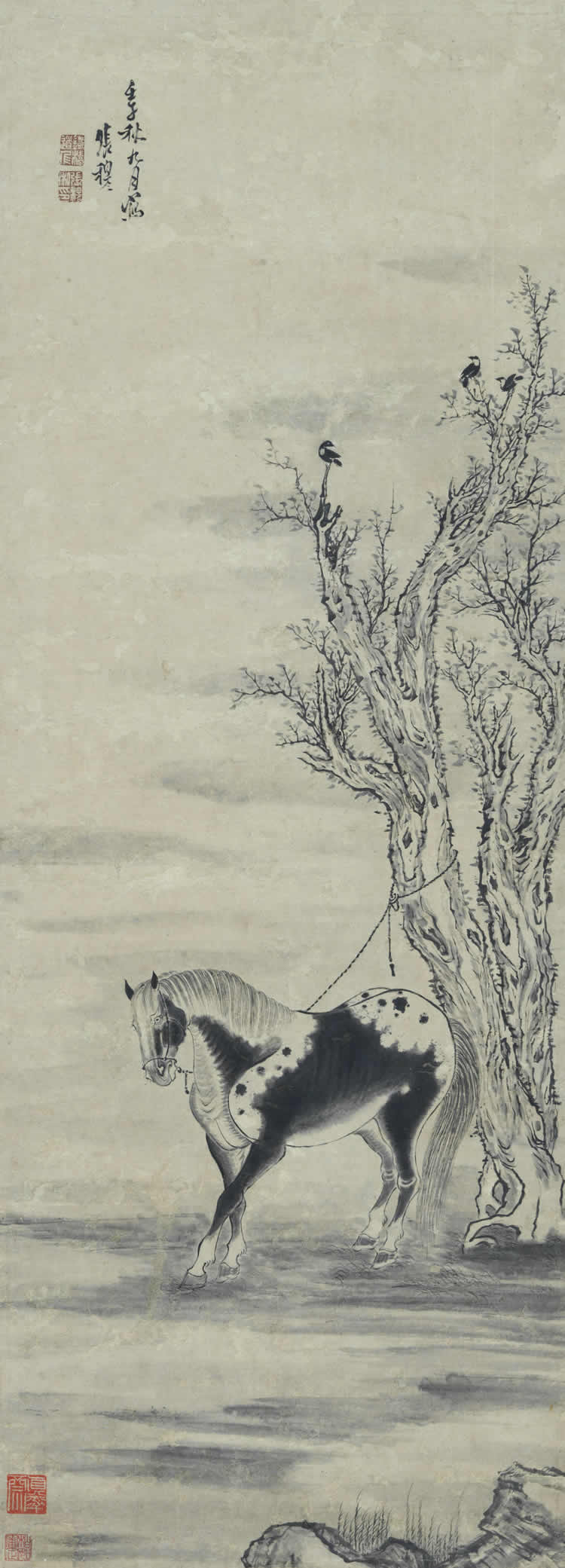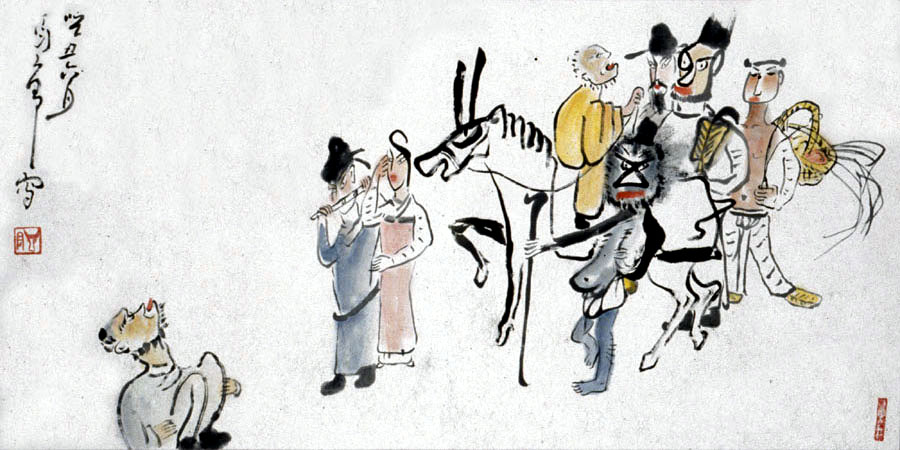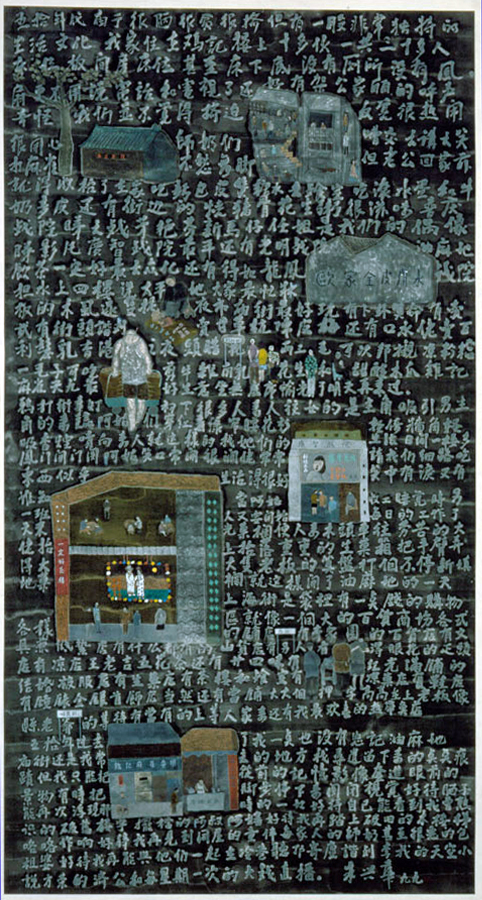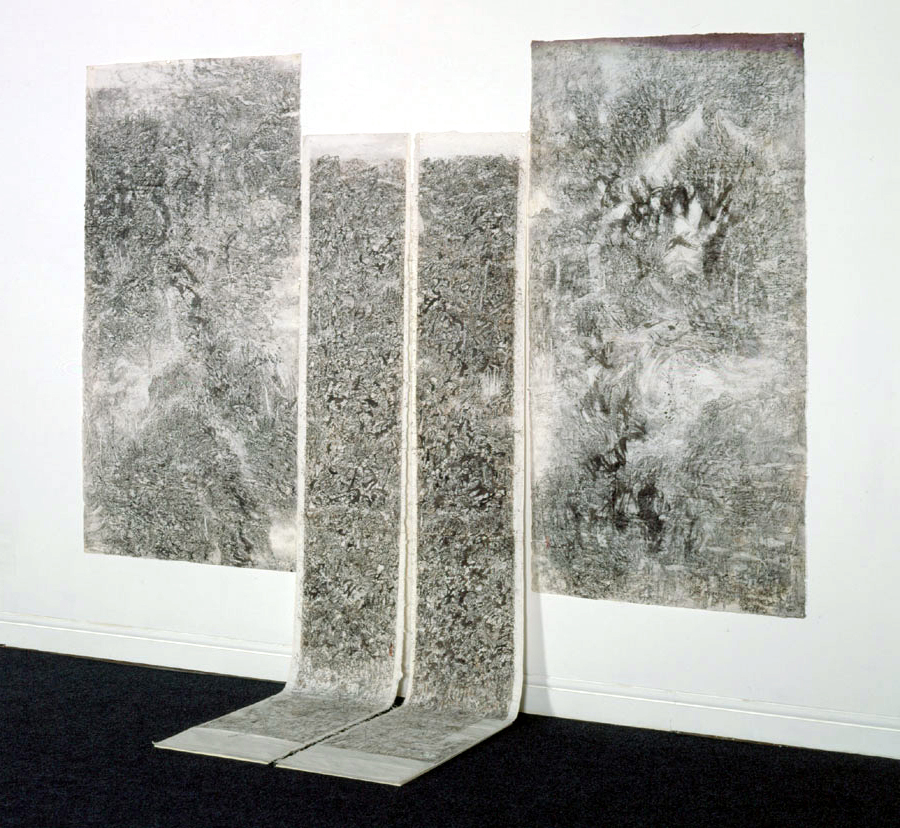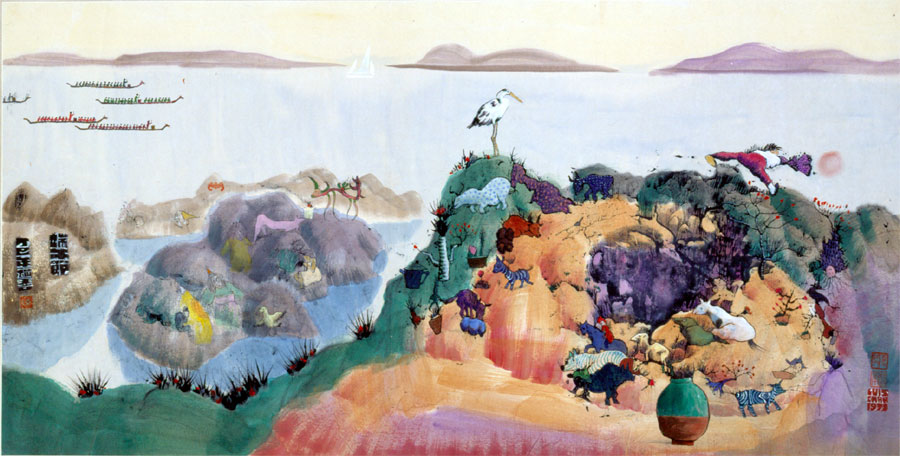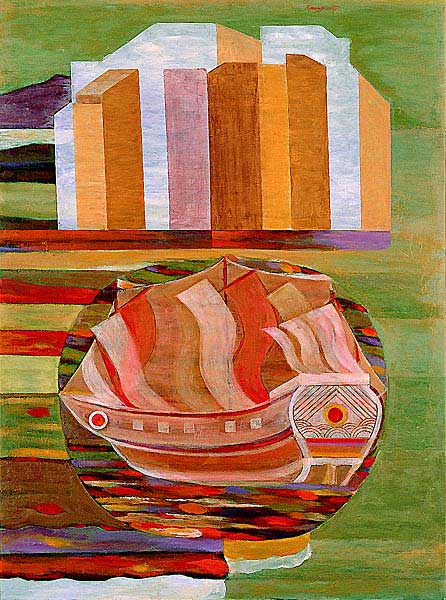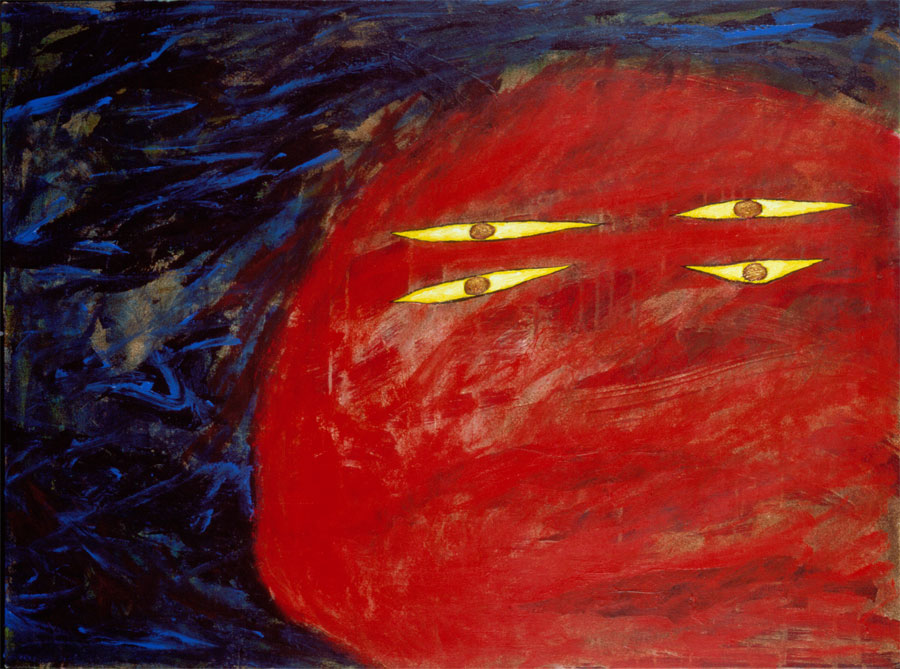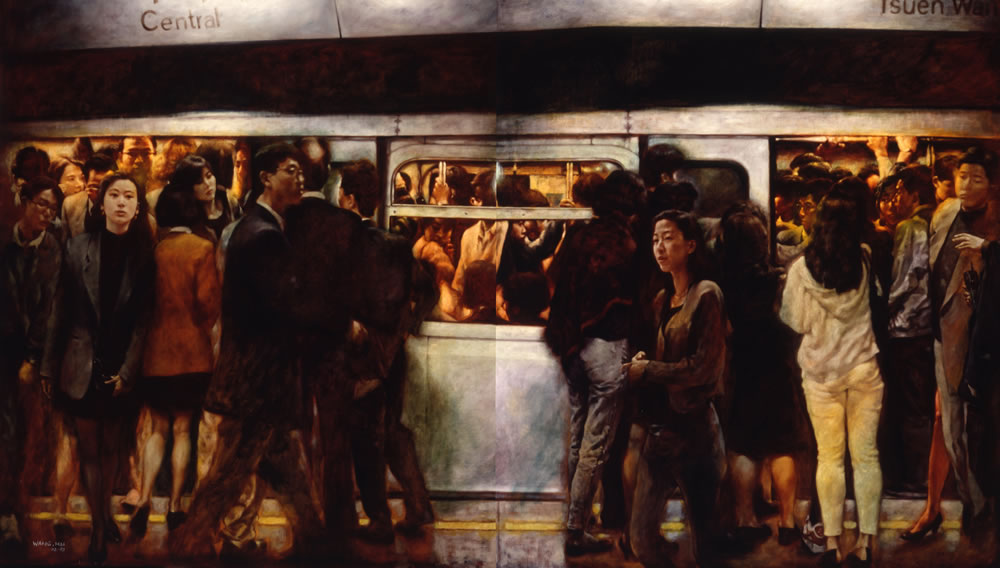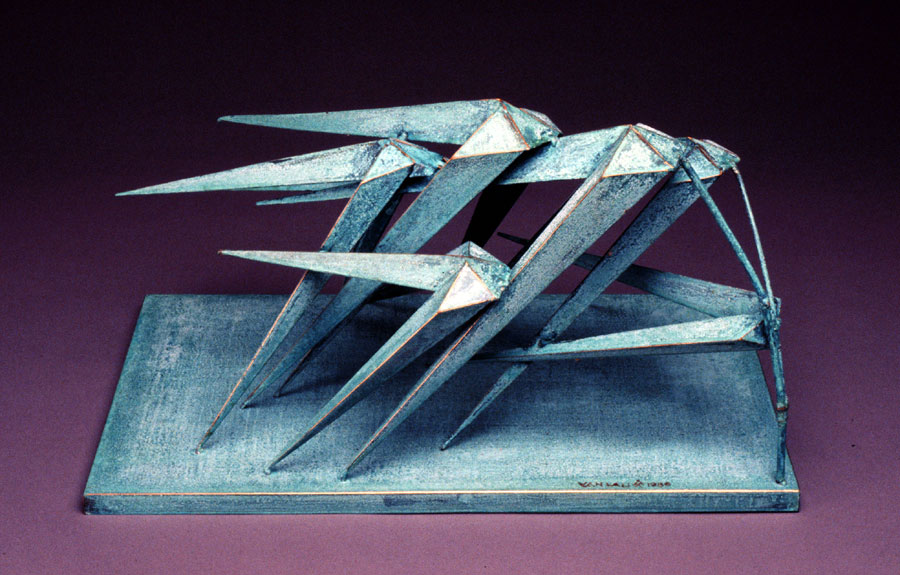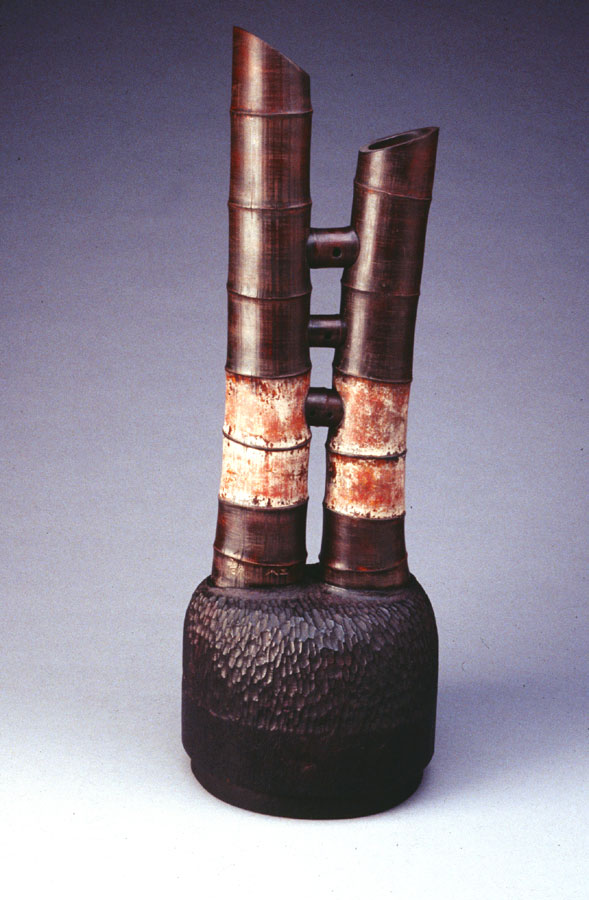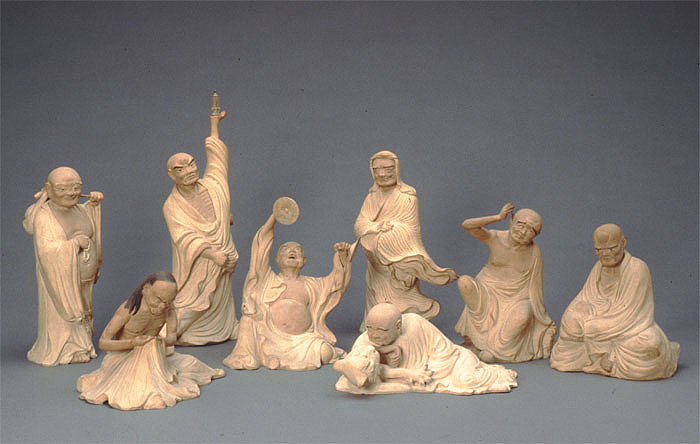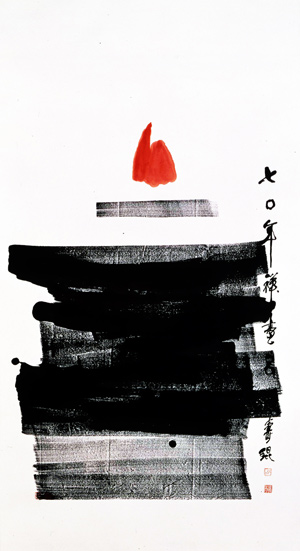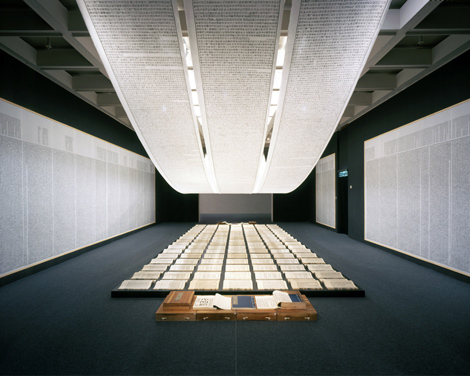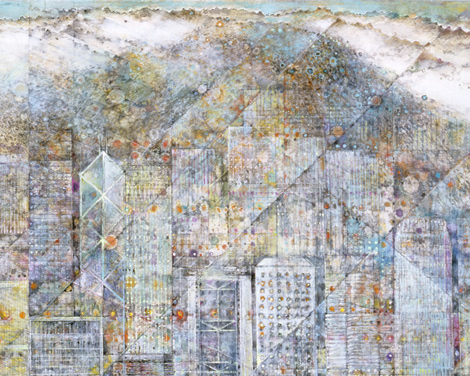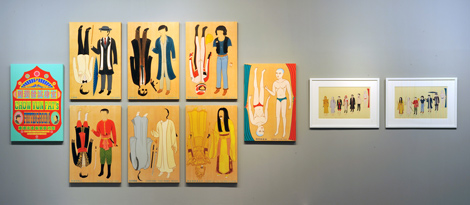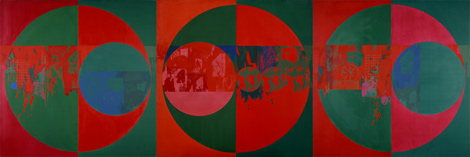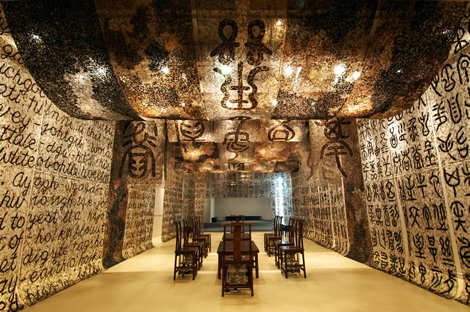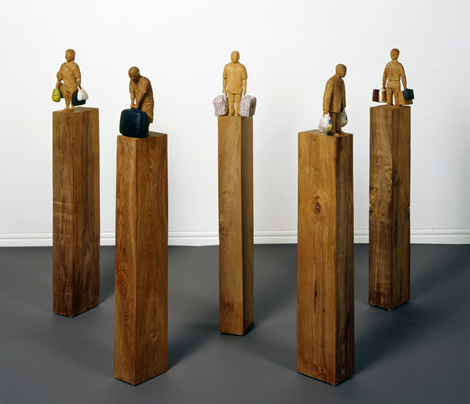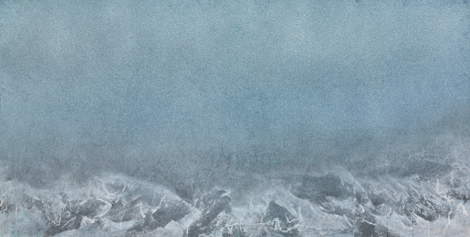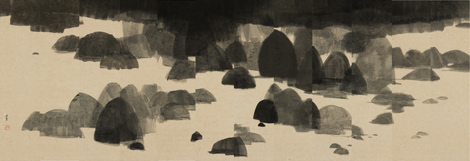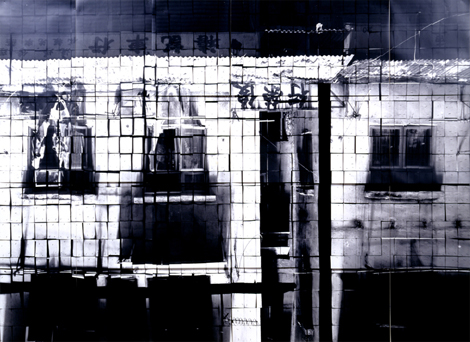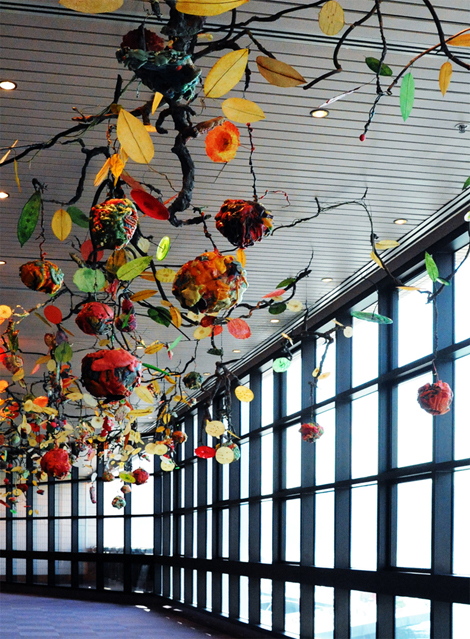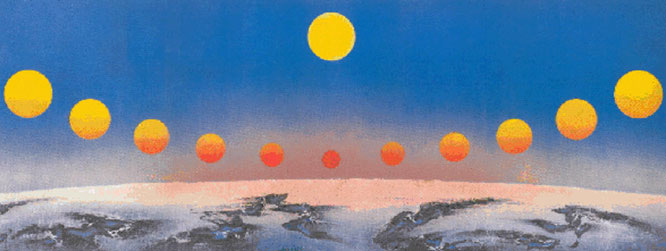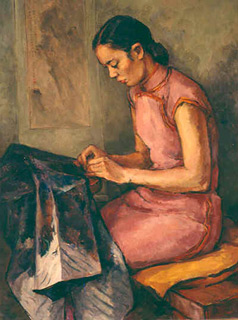 Web Content Display
Web Content Display
Modern and Hong Kong Art
Once derided as a barren rock, it took Hong Kong just over a century to develop from a simple fishing port into an international trade centre hustling and bustling with activity. The vast majority of the population of Chinese living with the small but significant proportion of residents from other countries makes for a colourful mix of East and West, and while life in the territory remains firmly rooted in Chinese traditions, Western trends have always represented an attraction. The result? An exhilarating pluralistic society of a wonderfully diverse cultural character. Hong Kong artists are not unaffected by this heady brew: constantly searching for their Chinese roots while absorbing the exciting new spirit of the times, they aim at innovation and change and are today shaping a unique art that is redolent of a global vision yet steeped in local colour.
Spanning just over 100 years, the history of Hong Kong art experienced its first flowering in the 1920s and 1930s. Famous artists from the mainland settled in Hong Kong or frequently came to the territory to exchange information and opinions, while a number of art societies sprang up in quick succession. Artists who studied abroad returned to Hong Kong and brought with them the popular trends in Western art, enriching the perspectives of artistic development of Hong Kong.
After 1949, mainland masters emigrated to Hong Kong and they revitalized the art of traditional Chinese painting and calligraphy in the territory. Modern Hong Kong art flourished in the 1950s and 1960s. With the influx of modernism, the winds of innovation swept powerfully through cultural circles. Artists of the New Ink Painting Movement attempted to introduce new ideas and techniques into traditional ink painting to enrich its means of expression. At the same time, another group of artists used Western media to convey the essence of Chinese culture, creating a distinctive style by fusing the traditions of Orient and Occident.
Since the 1970s, artists who were born and raised in Hong Kong during the post-war period also introducing local culture that is close to the contemporary spirit for the art world and forming a cross-media art development. They are all devoted to exploring their own identity and artistic possibilities, making this period the key to Hong Kong people's establishment of their own cultural identity.
-
Eight Immortals
-
Ding Yanyong (1902 – 1978)
-
1973
-
Ink and colour on paper
-
69 x 138 cm
Ding Yanyong was born in the Guangdong province of China in 1902. Between 1919 and 1925, he studied painting at the Tokyo College of Fine Arts and was particularly attracted to Western painting. He settled in Hong Kong in 1949.
Ding Yanyong studied oil painting at first and subsequently turned to traditional Chinese painting. He was profoundly influenced by Bada Shanren (1626–1705) and Shi Tao (1642–1707); and was able to blend Chinese and Western techniques to form his own unique style. In the present work, taking his cue from Bada Shanren, he brings out the essence of the Eight Immortals using bold, clean strokes to combine rugged sincerity of expressionism with an exaggerated humour in his characterisation. Lü Dongbin, one of the Immortals depicted in the right bottom corner of the painting, who haughtily keeps his distance from the others, turning his head towards heaven, which is nothing short of a self-portrait of the artist who scorned the vulgar world. -
-
Blooming flowers
-
Yang Shen-sum (1913 – 2004)
-
1975
-
Ink and colour on paper
-
120 x 30 cm
Yang Shen-sum was born in Guangdong province, China in 1913. He was one of the masters of the Lingnan School. In addition to being greatly influenced by two masters of the Lingnan School, Gao Jianfu and Gao Qifeng, Yang was also inspired by Japanese ink painting. He inherited the stark, poetic beauty of the Kyoto School and the bright colouring of the Geshan School, which, when added to his love for nature and partiality for life drawings, made his works appear lively and energetic.
The present work reveals the influence of the Japanese artist Taheuchi Seiho (1864–1942) in his early years. Using a technique of plain line sketching and a well-planned composition, Yang created a hazy and harmonious atmosphere and poetic image of small birds nestling under the leaves of the intertwining branches of garden cosmos. -
-
Midsummer
-
Chou Lu-yun, Irene (1924 – 2011)
-
1983
-
Ink and colour on paper
-
138 x 69.5 cm
Irene Chou was born in Shanghai province, China in 1924 and moved to Hong Kong in 1949. She learned Chinese traditional painting from a master of the Lingnan School, Zhao Shao'ang. In the 1960s, under the influence of the New Ink Painting Movement led by Lui Shou-kwan, she created unique textures and images, using oil, acrylic, watercolour, etc, on rice paper. These innovations were based on traditional Chinese painting. Her painting fully illustrates her delicate and sensitive feminine touch.
In the present work, abandoning the themes of traditional ink painting, Irene achieves abstract whirlpool motifs with a great movement using a unique creasing technique. The bright red in the middle symbolizes a pulsating cell as well as boundless space, which adds an atmosphere of mystery and profundity to the picture without losing its modernity. -
-
The Yellow River
-
Fang Zhaoling (1914 – 2006)
-
1988
-
Ink and colour on paper
-
144.2 x 189.6 cm
Fang Zhaoling was born in Jiangsu province, China in 1914. In her youth she studied with masters of Chinese painting such as Qian Songyan, Zhao Shao'ang and Zhang Daqian. She excelled following the teachings of her masters but was unfettered by conventions. Her work is characterized by bold strokes of paint in strong colours, with a sense of naivety and dis-adherence to any particular style.
The dominant colour of the present work is a sienna brownish red. The outlines of mountains and rocks were achieved in such a way as to suggest a pictorial reference to the cursive script. The composition form is bold; the expansive Yellow River Plateau's giant boulders contrast strongly with tiny human figures and houses, highlighting the enormous power of the landscape. Furthermore, the boats sailing on the river echo the artist's feelings for her native land and her good wishes for the people living in the land. -
-
My days in Temple Street
-
Chu Hing-wah (1935 – )
-
1999
-
Ink and colour on paper
-
180 x 96 cm
Chu Hing-wah was born in Guangdong province, China in 1935. His paintings are directly under the edifying influence of Western culture, but he also retains the aspect of Chinese culture, using pigments and Chinese ink applied with the technique of layering and diffusion. He expresses his care for human feelings and the affairs of human life.
In the present works, Chu Hing-wah uses scripts and images to recount the sight and sounds he experienced when he lived in Temple Street 10 years ago. The densely written scripts in the painting reminds us of the crowded Temple Street, a place that has always been called the 'night club of the populace'. The artist has used extraordinary colours and compositional arrangements to piece together his memory of old Hong Kong and his sentimental attachment to the fragmented episodes that he recalls. -
-
Rustic
-
Leung Kui-ting (1945 – )
-
2001
-
Ink and colour on paper
-
280 x 273.7 cm
Leung Kui-ting was born in 1945 in Guangdong province, China. Starting in 1964, Leung became a student of the noted Hong Kong artist Lui Shou-kwan. He later took up an art and design course at the Extra Mural Department of The Chinese University of Hong Kong.
In the present work, Leung Kui-ting has created kinetic movement and imagery by emphasizing free brush manipulation. When it comes to perspective, Leung has abandoned tradition by entirely reconstructing the landscape. Mountain and rock formations are reinvented, and trees and streams weave in abstract patterns. The overall presentation of this work is reminiscent of installation art: two narrow scrolls of rolling landforms and running streams which contain all the details of a traditional landscape painting with plain line flowers running down to the ground between two vertical scrolls. This innovative concept breaks away from the traditional appreciation of landscape paintings. -
-
A set of twenty scrolls of calligraphy after ancient scripts (part)
-
Fung Hong-hou (1901 – 1983)
-
1977-1979
-
Ink on paper
-
136 x 36.5 cm
Fung Hong-hou was born in 1901. Like many artists from the Guangdong province, China, Fung Hong-hou moved to Hong Kong after the Second World War. A master in ancient scripts, seal carving and calligraphy, Fung had an in-depth knowledge in the bronze of the Shang (c. 16 th – 11 th c. BC) and Zhou (c.11 th c. – 256 BC) dynasties, the stele inscriptions of the Qin (221 – 207 BC) and Han (206 BC – AD 220) dynasties, as well as inscriptions on cloth and bamboo slips. Through tireless practice, he managed to capture the essence of these different styles to create his own unique style, which combines the solid smoothness of the seal script and the strength and breadth of the Han and the Northern scripts.
The present works comes in a set of twenty, they bear ample evidence of the artistic accomplishment of Fung: his bronze and stone inscription style embodies a spirit of honesty and simplicity, and his stele style glows with individuality. What is even more admirable is that his creativity shines through even in the dedication and signature: the small script used for these have captured the essence of the seal and clerical styles in such a way that as if it exudes an air of the ancient. -
-
Artistic words by Shi Tao in combined script
-
Yip Man-yam (1949 – )
-
2000
-
Ink on paper
-
137.7 x 30.6 cm
Yip Man-yam was born in Shanghai province, China in 1949. He took an apprenticeship in Chinese calligraphy from Lai Chu-sheng and in seal carving from Chen Ju-lai. He resettled in Hong Kong in 1982.
Yip's work draws upon the famous Qing Dynasty artist Shi Tao, who proposed that calligraphy should be contemporaneous and evolve with the times. The present work is what Yip calls 'a combined script', which he himself created. Its style is reminiscent of the clerical script. Yet, by introducing a spatial arrangement of ancient seal carvings, the composition also exudes a classical, antique charm. This innovative and stylish script is the artist's attempt to explore distortion, contrast and pictorial elements in calligraphic art. -
-
Dragon boat festival
-
Luis Chan (1905 – 1995)
-
1977
-
Ink and colour on paper
-
69 x 135 cm
Luis Chan was born in Panama in 1905 and settled in Hong Kong in 1910. The source of his paintings has always been based on landscapes of Hong Kong and his own state of mind. For several decades, he has been continuously representing what he has seen and heard in Hong Kong by combining the styles of Chinese and Western art, and the new with the old.
He expresses his subconscious ideas in his paintings, such as the distorted, mysterious animals and objects that are scattered throughout the present work. The dragon boats in the painting have already become the symbol of dragon boat festival in contemporary Hong Kong. This festival, which was originally dedicated to the commemoration of the great Chinese poet Qu Yuan of the third century B.C. has also developed into a festival in which many traditional activities are held. Nowadays, watching dragon boat racing in the festival has also become a leisure activity for families, providing physical and mental relaxation. -
-
Hong Kong 1897-1997 waterfront
-
Kwong Yeu-ting (1922 – 2011)
-
1991
-
Oil on board
-
122 x 91 cm
Kwong Yeu-ting was born in Macau in 1922 and graduated from Kansas State University, United States in 1949, with a Master degree in Landscape Design. In 1956, Kwong studied painting in England, France and Italy. He specialized in oil painting and printmaking.
In the present work, Kwong Yeu-ting has unfolded the changes that Hong Kong underwent during this century, through the juxtaposition of time and space. He has chosen a junk as the symbol of Hong Kong a hundred years ago, and high-rise buildings as the distinctive feature of today's Hong Kong. In regard to the rendition of the painting, the artist juxtaposes abstract pattern and bright colour scales with the symbols of two different eras of Hong Kong to attain harmony. -
-
Reclusion
-
Wucius Wong (1936 – )
-
1978
-
Ink and colour on paper
-
40 x 185 cm
Wucius Wong was born in 1936. In the 1960s, Wong studied art in the United States. He is a noted artist and art critic in Hong Kong. His landscapes reveal his unique communication with nature, and suggest a heart that wanting to escape from the concrete jungle of urban living.
In this landscape painting of mountains and clouds, the seeming continuity in the layout demonstrates the use of spatial composition. Finely executed lines and washes of colour further show the artist's unique style of ink painting. Although the composition breaks away from traditional Chinese landscape painting, the colour and graphic detail of the landscapes reveal the composition's traditional roots. It shows an integration of traditional landscape imagery and modern geometrical designs. -
-
The story of eyes
-
Gaylord Chan (1925 – )
-
1996
-
Acrylic on canvas
-
92 x 122 cm
Gaylord Chan was born in Hong Kong in 1925. He is a well-known abstract artist in Hong Kong. Although he only started painting when he was forty years old, he has since won numerous awards for his works.
In the present work, a round red patch on the right and two pairs of eyes are peer out of the canvas. Gaylord Chan has tried to convey a sense of weight, space and texture by using different painting techniques. At the edge of the round patch, he has used solid colours to highlight the density of the circle, adding weight and substance to it. In the translucent centre of the red patch and the blue strokes on the dark background, he has used loose, sketchy brushstrokes that allow lower layers of paint to show through. This technique has enhanced the composition's strong texture. -
-
From Tsuen Wan to Central
-
Wang Hai (1955 – )
-
1992
-
Diptych, oil on canvas
-
154 x 274 cm
Wang Hai was born in 1955 in the Sichuan province, China. He graduated from the Sichuan Academy of Fine Arts, majoring in painting. Wang Hai moved to Hong Kong in 1988. His paintings often display his understanding of the culture of Hong Kong. They are executed in a realistic style but with sarcasm, using the form of traditional religious portraiture of the West to represent the history of Hong Kong and the phenomena seen in people's livelihood. Through these works, he recounts his feelings towards Hong Kong and his relationship with her.
It takes about three hours to travel from Tsuen Wan to Central by Mass Transit Railway and then from Central to Lamma Island by ferry. This is the same exact journey the artist must take to travel from home to his painting studio. In this painting, an impressive scene of a crowd in an MTR train is rendered by the artist in a dramatic way. -
-
Bamboo in the wind
-
Van Lau (1933 – )
-
1988
-
Brass
-
H 25.5 cm L 45.6 cm W 28.2 cm
Van Lau was born in the Guangdong province of China in 1933. He resettled in Hong Kong in 1960. Inheriting the spirit of Chinese culture, Van Lau draws his subject matters from traditional and folk art. With different materials such as bronze, stainless steel and stone, he creates works in geometric abstract forms, and his distinctive style is a fusion of Eastern and Western artistic influence.
Bamboo has a profound cultural meaning in China. It symbolizes loyalty and fidelity and because of these qualities, Van chose bamboo as his one of the favourite subjects. In the present work, he has captured the movement of bamboo leaves in the wind. The bamboo leaves are randomly placed with charming abstract beauty. -
-
Fortune 12
-
Cheung Yee (1936 – 2019)
-
1976
-
Wood
-
H 274.5 cm W 274.5 cm D 15 cm
Cheung Yee was born in the Guangdong province of China in 1936. He is an acclaimed Hong Kong artist who is able to master diversified artistic creations. His sculptures and prints possess a strong personal style with a unique vocabulary by borrowing archaic Chinese motifs such as ancient oracle bone scripts, tortoise shell as well as primitive art.
This double-sided openwork relief sculpture is modeled with four totem poles. Each tortoise shell is carved with round holes that look like limpets and almond-shaped holes that represent the indentations, and the wriggling worms eaten traces link up various front and back void spaces. This representative work conveys an archaic and mythical aura with a touch of solemnity and dynamism. -
-
Music bamboo
-
Ha Bik-chuen (1925 – 2009)
-
1985
-
Bamboo and wood
-
H 125 cm L 42 cm W 42 cm
Ha Bik-chuen was born in 1925 in the Guangdong province of China. He began practising the art of sculpture in 1960. Ha Bik-chuen's works often exude an air of earthiness. He draws inspiration from nature, and nature richly rewards him in the process.
The unique form of the present work is noteworthy for its simplicity and use of naturalistic colours. The solid wood base is fitted with two sections of bamboo, giving it the appearance of the ancient Chinese musical instrument, yu. Look carefully and the entire composition will seem to be quietly emanating the resonance. The red and black pigments on the bamboo give it an appealing touch of antiquity, while the sculpture's innate repose and quiet aura stir the imagination. -
-
Untitled (After dream of a path)
-
Leung Chi-wo (1968 – )
-
1996
-
Set of 5, oil on paper
-
Each 244 x 60 cm
Leung Chi-wo was born in Hong Kong in 1968. He obtained a Master of Fine Arts degree from The Chinese University of Hong Kong in 1997 and has studied photography in Italy. He likes to work with pinhole photography and mixed media when exploring cityscapes. His compositions often capture faces and aim to reveal the emotional relationships of today's urban man.
The present work is the recollection of an installation created in 1996 by Leung Chi-wo. The installation was a carving on the site's cement floor of a menu from a 1960s noodle stall. When the exhibition was over, Leung made rubbings of the carving and mounted them in the style of a folding screen with Chinese calligraphy and paintings. The present work is a flashback to Leung's original work and nostalgia for a bygone era. It is the artist's tribute to his childhood days and by incorporating mixed media with the traditional mounting of Chinese calligraphy and painting, the original work has been revitalized as a new and vibrant artistic expression. -
-
The eighteen lohans (part)
-
Ho Ping-chung (1918 – 1999)
-
Early 1970s
-
A set of 18, stoneware
-
Size variable
Ho Ping-chung was born in 1918 in the Guangdong province of China. Ho Ping-chung studied pottery in the Shiwan province of China and was inspired by well-known potters including Liao Jan, Liang Huapu and Liang Shipei. He excelled in producing Shiwan pottery wares.
The Eighteen Luohans biscuit figures is a superb example of the lifelike quality of Ho Ping-chung's work. Ho had taken references from senior masters, ancient paintings as well as Buddhist sutra, yet his Luohans have human touch. The unglazed figures reveal the exquisite craftsmanship in the delicacy of the drapery, and in the lifelike quality of flesh and muscle. The wood chisel forcefully working on the biscuit clay forms different lines of the wavy sleeves or folded cloth similar to brushstrokes of Chinese figure painting. He was well-versed in the art of calligraphy and painting and his styles are reflected in his ceramic pieces. -
-
Yuanyang "Y" pots / Yuanyang "X" pots (parts)
-
Lo Sze-lim, Chris (1967 – )
-
2002
-
A set of 5, pottery, throwing, casting and mixed media
-
Size variable
Chris Lo studied Fine arts and graduated with a Bachelor degree from The Chinese University of Hong Kong in 1990. He specializes in ceramic art after his graduation. He founded his own studio 'Cobo Ceramic Workshop' in 1996 which he devotes to art education and artistic creation.
In his works, he explores the relationships between man, time and space which are rustic in form and texture, conveying a sense of simplicity. Through ceramic installations, Lo depicts different interpretations of life and spiritual matters. In the present work, using simple form and natural tone glaze provide an archaic flavor. The similar forms carry the opposite meaning. The shape and the lines imply the contradictory and harmonious relationship between people. -
-
Zen painting
-
Lui Shou-kwan (1919 – 1975)
-
1970
-
Ink and colour on paper
-
180 x 97 cm
A native of Guangzhou, Guangdong, Lui graduated from Guangzhou University. In 1948, he moved to Hong Kong. He studied painting from his father Lui Canming, devoting himself in his early years to mostly painting landscapes and flowers in the traditional style. Later, he turned to abstract painting. He developed ‘Zen Painting' by blending philosophical concepts of Taoism and Buddhism with Chinese ink painting techniques in a distinctive manner. He thus initiated the New Ink Painting Movement, which significantly impacted the Hong Kong art circle.
The red dot is inspired and derives from the lotus of Buddhism and is commonly found in Lui's works from the 1960s and 1970s. The broad strokes, dynamic lines and washes contrast with the striking expanses of white space. The intricate balance between black and white, substance and void are symbolic of the dynamic balance of the cosmic yin and yang. The lotus represents the purity and tranquillity that lies beyond the chaos of the world. -
-
A book from the sky
-
Xu Bing (1955 – )
-
1987 – 1991
-
Mixed media
-
1500 x 850 x 400 cm
-
Sponsored by Bei Shan Tang Foundation
An internationally acclaimed Chinese contemporary artist, Xu enrolled in the Central Academy of Fine Arts in Beijing and received a Master of Fine Arts degree in printmaking in 1987. After settling in the United States in 1990, he won the esteemed Genius Award by the MacArthur Foundation in 1999, and the Artes Mundi (Arts of the World) Prize in 2004.
This work has evolved from the regular script in Chinese calligraphy. Xu has reassembled Chinese radicals, designing and carving square-block characters that look very similar to traditional Chinese logographs but are entirely meaningless in terms of linguistic function. He patterned all his characters after the classical style used for printing. In addition, he hand-printed the vertical scrolls presented them in the installation in traditional Chinese stitch-bound format. In A book from the sky, the space is overwhelmed by all these unreadable characters. As a result, it merges Chinese and western art elements and shakes the tradition of Chinese writing at its core. -
-
Everlasting
-
Cheung Yee (1936 – 2019)
-
1970
-
Bronze
-
83 x 58 cm
Cheung Yee was born in Guangzhou, China. He started making sculptures after returning to Hong Kong in the late 1950's, and held his first solo exhibition at the City Hall Museum and Art Gallery (now the Hong Kong Museum of Art) in 1964. He was made a Member of the Order of the British Empire (MBE) in 1979. He was on the faculty of the Department of Fine Arts at The Chinese University of Hong Kong before resettling in Los Angeles, the U.S., in 1998.
Cheung's art integrates elements of western and Chinese aesthetics, and embraces a dichotomy between tradition and modernity through the use of symbols and motifs in ancient totem art and western modern art concepts. The tortoise-shell has always been his favourite theme, interpreted with burnt marks, holes and cracks on oracle bones. They have become his signature in art. This work is inspired by the oracle turtle shell, and has a geometric layout rich in modern design elements. The bronze colour and texture accentuate the link to antiquity. -
-
Scintillating Hong Kong harbour (detail)
-
Wucius Wong (1936 – )
-
1999
-
Ink and colour on paper, album
-
47 x 373.6 cm
Wucius Wong, born "Wong Chung Ki" in Dongguan, Guangdong, moved to Hong Kong in 1938 and began learning painting from Lui Shou-kwan in 1958. He graduated from the Maryland Institute College of Art in the United States with a BFA and an MFA degree in the early 1960's. He was a principal lecturer at the Swire School of Design, Hong Kong Polytechnic in 1974, and was appointed honorary adviser of the Hong Kong Museum of Art in 1976 before resettling in the United States in 1984. He moved back to Hong Kong in 1996.
On returning to Hong Kong in the 1990's, Wong began using scenes of Hong Kong as his subject. This is one of the celebration series for the handover of Hong Kong. It represents his dream of "homecoming". Here he has used geometric elements and Impressionistic stippling techniques to recreate the Hong Kong waterfront, in a romantic vision of a new era and expression of his love for his homeland. -
-
Chow Yun Fat's fitting room
-
Shieh Ka-ho, Wilson (1970 – )
-
2009
-
A set of 10, acrylic on canvas, digital print and gouache on paper
-
8 pieces of paintings, each 120 x 80 cm; 2 pieces of collages, each 50 x 80 cm
Born in Hong Kong, Wilson Shieh received a BA in 1994 and later an MA in the Department of Fine Arts at The Chinese University of Hong Kong in 2001. He is known for his gongbi painting technique, yet despite the traditional idiom, his works are characterized by decorative elements as well as reflections on pop culture.
In this portrayal of Chow Yun-fat, the famous actor from Hong Kong, Shieh has put together the many characters Chow portrayed in movies to illustrate his career and transformation from a local actor to a Hollywood star, and to explore the issue of identity in Hong Kong's pop culture. The use of acrylic and collage of prints demonstrates intellectual explorations of how outlooks and image-making, viz. conscious dressing and deliberation, can project different levels of meanings and reflect the transformation of culture in different media. -
-
Bath of fire
-
Hon Chi-fun (1922 – 2019)
-
1968
-
Set of 3, oil and silkscreen on canvas
-
132.1 x 396.3 cm
Born in Hong Kong, Hon Chi-fun received his secondary education from Wah Yan College Hong Kong in 1941. He started painting as a self-taught artist while working in the Post Office. He moved to Canada in 1990 and returned to Hong Kong in 2000. Although he suffered a minor stroke the same year, he never gave up on art.
The 1960's was his "abstract period". Working with a variety of media and techniques, he combined photography with silkscreen prints and acrylic to create series of paintings. Strong and complementary colours, circles and squares that bedazzle the viewer figured prominently in his choice of forms, making them his signature iconography and Hon a leading edge artist of his time. -
-
United Nations series – China monument: temple of heaven
-
Gu Wenda (1955 – )
-
1998
-
Mixed media
-
Approx. 300 sq.m.
-
Donated by the Asia Society Hong Kong Center
A renowned contemporary Chinese artist, Gu was born in Shanghai, China and received his Master's degree from the Zhejiang Academy of Fine Arts in 1981. He has settled in the United States since 1987. This piece is made of translucent hanging scrolls with human hair sewn into them. The pseudo-languages created by the artist are derived from Chinese, English, Arabic and Hindi and may appear to the viewer standing at a distance as the mythos of a long-lost civilization. These unrecognizable and undecipherable symbols are illegible to all audiences. The piece represents the misunderstanding, fear and anxiety that exist among different cultures. -
-
Baggage
-
Fung Lik-yan, Kevin (1964 – )
-
2005
-
A set of 5, painted teak
-
120 x 200 x 200 cm
Born in Hong Kong, Kevin Fung studied contemporary sculpture at the Department of Extra-mural Studies of The University of Hong Kong and wood carving under renowned artist Tong King-sum. He also studied the kiln-working glass course at Canada's Sheridan College. Fung's particular interest lies in wood carving and depicting human figures of the middle socio-economic class.
Here the artist explores life in Hong Kong after the economic downturn through his portrayal of five figures: a taxi driver with the luggage of his fare, a white-collar man who goes shopping at the supermarket after work, a housewife carrying her child's schoolbag, a bell boy taking the shopping bags from hotel guests, and a "human shuttle" who drags stripe bags heavy with goods across the border of Hong Kong and Lowu. On the surface, life seems good, at least materially speaking: there are shoppers on the street and in the shops, so Hong Kong must have bounced back. But has it? The shadow of fear and uncertainty about the future lurks in every Hongkonger's mind… -
-
Heavy snowing
-
Liu Guosong (1932 – )
-
2009
-
Ink and colour on paper
-
94 x 186 cm
Liu Guosong was born in Anhui, China, but his family were originally from Shandong. He settled in Taiwan in 1949. He learned traditional Chinese painting at a young age and later shifted his studies to Western painting. After graduating from university in Taiwan, he founded the "Fifth Moon Group" and became the leader of the movement of modern art. Liu has taught in many universities around the world. He served as Chair of the Department of Fine Arts at The Chinese University of Hong Kong, Visiting Professor at the University of Iowa and Stout State University in Wisconsin, United States and Dean of the Graduate School of Plastic Arts at the Tainan College of Arts.
This painting of a surreal snow-covered landscape is an example of how the artist draws his inspiration from nature. At once magnificent and quiet, pristine and profound, poetic and impressive, it has a compelling aura that entrances and inspires. -
-
Once upon a time
-
Fung Wing-kee, Raymond (1952 – )
-
2009
-
Set of 12, ink on paper
-
138 x 420 cm
Fung Wing-kee, Raymond, was born in Hong Kong and started learning Chinese painting in 1967. He was awarded a Bachelor's degree in architecture from the Louisiana State University, USA in 1978. He completed a course in Chinese painting at the Department of Extramural Studies of The Chinese University of Hong Kong in 1985. Fung is an architect by profession, and is currently Adjunct Associate Professor in the School of Architecture at The Chinese University of Hong Kong, a member of the Development Committee under the Board of West Kowloon Cultural District Authority, and Museum Expert Adviser to the Leisure and Cultural Services Department, Hong Kong Special Administrative Region.
In this painting of the islands of Hong Kong, the artist uses simple and semi-abstract brush strokes together with design elements to depict Hong Kong's natural landscape devoid of urban development, thus creating a warm sense of calm in order to express his feelings for the place he calls home. -
-
No.17 – 19, Fung Yi Street
-
Ching Chin-wai (1972 – )
-
2002
-
Set of 24, pinhole photography, black and white prints
-
180 x 240 cm
Born in Hong Kong, Ching Chin-wai received an MFA from the Department of Fine Arts at The Chinese University of Hong Kong in 1999, and completed two artist-in-residence programmes – one at the Vermont Studio Center in the United States and the other at the Fukuoka Asian Art Museum, Japan - in 2006. His mixed media works were seen in many joint exhibitions in Hong Kong and other parts of the world.
Here the artist transforms an entire room into a pinhole camera to explore the possibilities of photography. Light passes through the small pinhole and projects a clear upside-down image of the scenery outside the window onto the interior wall. Inside this dark "camera", squarely-cut pieces of photo paper are pasted, by sheer touch, onto the wall as negatives. After exposure, the pieces are rearranged into one neat whole. -
-
To someone who wants to fly
-
Lam Laam, Jaffa (1973 – )
-
2003
-
Set of 23, wood
-
Size variable
-
Donated by Ms Lam Laam, Jaffa
Born in Fujian, Lam Laam, Jaffa, received her MFA degree from The Chinese University of Hong Kong in 1999. Lam has participated in several artist-in-residence programmes, and more recently was active in community and public art projects. She co-founded the AiR Association in a bid to initiate cultural exchange and public exploration of art.
Lam is known for her wooden sculptures and uses fairy tales as a way of self-expression. During the SARS outbreak of 2003, health care workers performed their duties with courage and some of them lost their lives as a result. She pays tribute to them with this piece where the broken wings stand firmly in everyone's heart as well as on this Heaven on Earth. -
-
Floating reeds
-
Fei Mingjie (Ming Fay) (1943 – )
-
2006
-
Mixed media
-
Size variable
-
Donated by The Friends of Hong Kong Museum of Art and The Ink Society Ltd.
Born in Shanghai, China, Fei Mingjie moved to Hong Kong in 1952. He studied Fine Arts at the Kansas City Art Institute and was awarded an MFA degree by the University of California in 1970. He has held solo exhibitions in Hong Kong, Taiwan and in the United States.
Fei is known for his botanical sculptures made from different types of materials, including copper, paper, twigs and seeds. This garden-like piece is based on inspiration from his studies of organic forms from East and West, both real and mythical and incorporates the use of industrial materials. He likes to introduce new ideas into his works that are generated from the accumulation of experience and knowledge. He makes sculptures that seek to understand the laws of nature and are full of symbolic significance. -
-
Moving? Staying?
-
Liu Guosong (1932 – )
-
1998
-
Set of 11, ink, acrylic and collage on paper
-
185 x 478 cm
-
Donated by Mr Liu Guosong
The universe moves in a smooth pattern that we can sometimes easily disregard. That is why Liu Guosong gave the name Moving? Staying? to this painting, one of the representative works from his well-known series The Space. Applying ink and acrylic on Guosong paper (consisting of shaggy cotton with fibres of varying thickness) and employing other techniques such as collage and mist spraying, Liu presents 12 suns all together in the universe of his imagination. The silence of space, profound and ever-lasting but also ever-changing, offers unlimited inspiration to the viewer. -
-
Sewing for you
-
Wong Siu-ling (1909 – 1989)
-
1941
-
Oil on canvas
-
89 x 120.5 cm
-
Donated by Ms Jeanette Hsu
Mu Shiying, the famous short story writer and founding member of the Hong Kong Literature and Art Association, once commented, "Wong's outstanding techniques were his well-conceived composition, his appropriate lines, his well-matched colour schemes and his powerful strokes." This painting of a lady in a pink qipao sewing a dragon robe of the Qing Dynasty against the backdrop of a landscape painting in ink, mirrors the pathos of life and reveals the links between different periods in China's history. -
-
Artificial landscape series (detail)
-
Almond Chu (1962 – )
-
2004
-
Set of 5, digital C-print
-
Each 121 x 151 cm
-
Donated by The Friends of the Hong Kong Museum of Art
"Reality is a suppositional arena" is the creative idea behind Almond Chu's series of photographs. Chu took photos of the landfill at Tseung Kwan O, the reservoir next to Tseung Kwan O Chinese Permanent Cemetery, a minefield at Shek O, a field full of construction waste at Yuen Long and a recycling plant at Chai Wan. The "landscapes" represented in these photos are all artificial, reflecting the destruction of nature by mankind. Chu hopes that the audience will show more concern for and take greater care of nature after viewing the situation we have now placed it in. -
Eight ImmortalsBlooming flowersMidsummerThe Yellow RiverMy days in Temple StreetRusticA set of twenty scrolls of calligraphy after ancient scripts (part)Artistic words by Shi Tao in combined scriptDragon boat festivalHong Kong 1897-1997 waterfrontReclusionThe story of eyesFrom Tsuen Wan to CentralBamboo in the windFortune 12Music bambooUntitled (After dream of a path)The eighteen lohans (part)Yuanyang "Y" pots / Yuanyang "X" pots (parts)Zen paintingA book from the skyEverlastingScintillating Hong Kong harbour (detail)Chow Yun Fat's fitting roomBath of fireUnited Nations series – China monument: temple of heavenBaggageHeavy snowingOnce upon a timeNo.17 – 19, Fung Yi StreetTo someone who wants to flyFloating reedsMoving? Staying?Sewing for youArtificial landscape series (detail)
